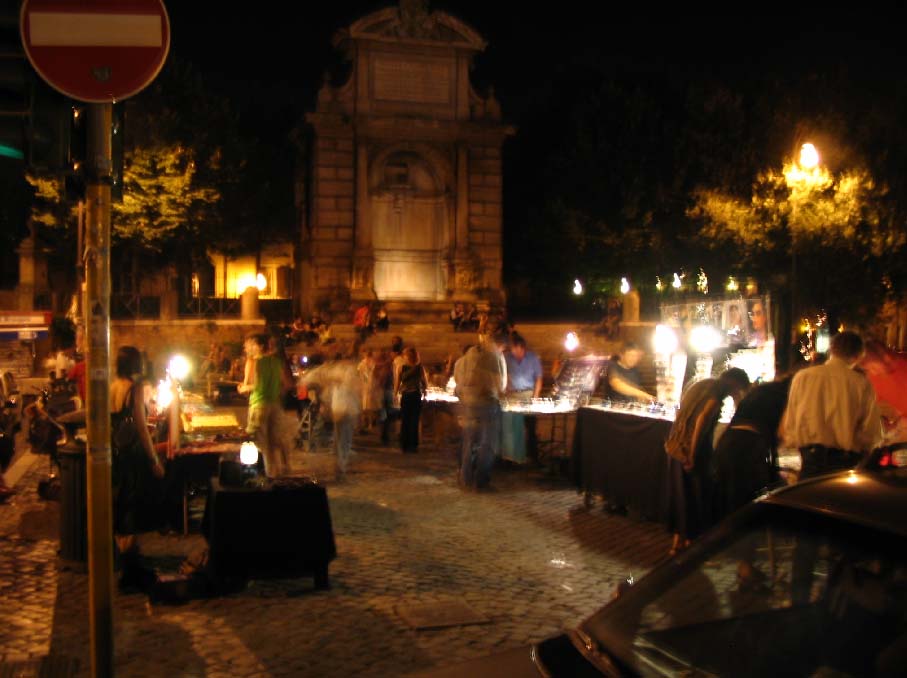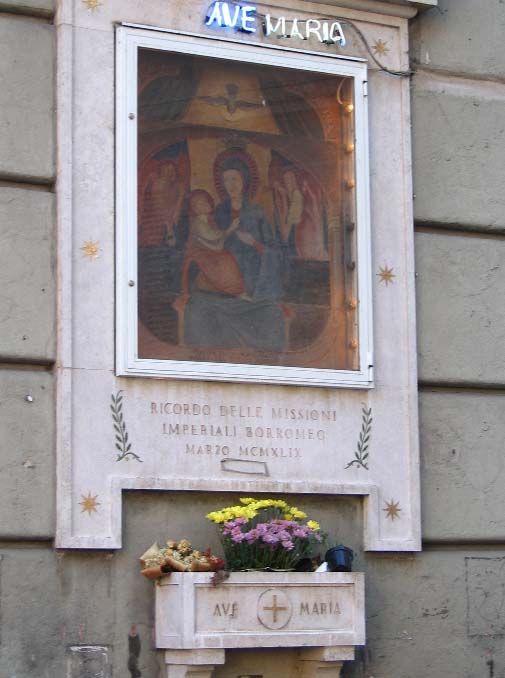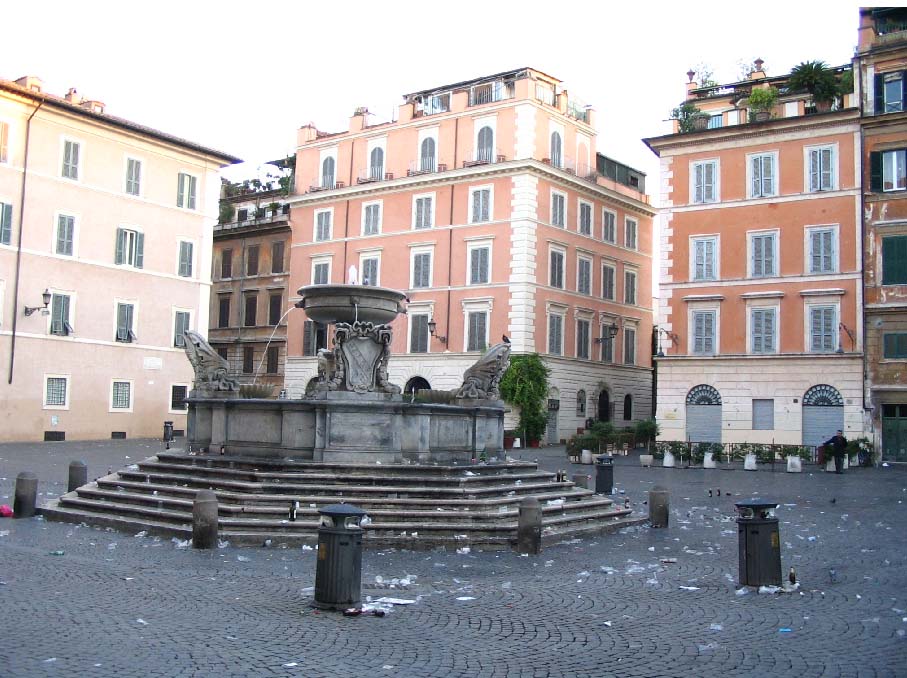|
|
 |
|
Trastevere: Where Tourists Meet Romans |
|
written
by zihengxu / 09.20.2004 |
|
|
|
|
|
| <click to type page headline> <use TAB to move to next textbox> |
1 of 1 |
|
| |
The social characteristics of the residents |
| |
| |

|
| Photo by Evan |
| Night in Trastevere |
| Trastevere has a great capacity for night life. Gelaterrias and bars attract a large group of young people. |
| |
|
| |

|
| Photo by Evan |
| Graffiti in Trastevere |
| Graffiti is every where! The contents also vary from anti-war, anti-Bush messages to random drawings. |
| |
|
Trastevere is known as one of the most fashionable Roman neighborhoods. As young adults, our observatory group felt that we fit into our surroundings very well. There are, however, variations in Trastevere, and other important items for us to address in illustrating the social structure of this part of Rome.
The social class of those who reside in Trastevere appears higher than the other side of the Tiber, in Campo di Fiori. We note the appearance of higher classes because of the elegant way in which passers-by dress in this area. Further wealth displays are seen in the cars driven in Trastevere, which seems to be newer, cleaner, and more expensive than what we have observed in other parts of Rome. Neighborhood aesthetics seems to be less important than personal appearance to the residents of Trastevere. For example, there are more graffiti in Trastevere than there are in the Campo.
There appears to be fewer immigrants in Trastevere than in other parts of Rome. There are, however, variations in the residents. For example, during the beginning of our tour, we saw a few ¡°punk¡±-looking teenagers congregated on a set of stairs leading to a fountain. These individuals sharply contrasted with the many groups of finely-dressed, middle-aged businessmen, who, in turn, contrasted with the majority of individuals we saw there, twenty to thirty year olds. This age group was predominantly quite trendy looking, and at 9:00 p.m., many were shopping or eating gelato (we approve!).
In terms of sexual preference, the only conclusion that we could come up with is that homosexuality is exceedingly difficult to determine. For example, we noted two men, who appeared to be an item of interest because of the way they dressed, by American standards, and because they were linking arms. However, these two met two women, whom they each proceeded to greet in a way that indicated that they were heterosexual, not homosexual. Based on this behavior, we must not draw conclusions about sexual preference based on physical observations alone.
Of course, heterosexual behaviors stand out much more. Obvious French-Kissing can be seen all around the area. Homosexual behaviors, as mentioned above, are rather difficult to identify.
|
| |
|
| |
|
| |
The distinctive economic and consumption activity in the neighborhood |
| |
| |

|
| Photo by Evan |
| Piazza Trilussa in Trastevere |
| Vendors set up tables with displays of beaded bracelets and rings, sunglasses, and scarves. Activities in this immediate piazza acorss the Tiber is similar to the activities near Campo di Fiori. |
| |
|
When we crossed the Tiber and ventured into Trastevere, we did not find many immediate striking differences between economic activities. The economic activities on both ends of the Ponte Sisto Bridge (the walking bridge that connects Trastevere with the other side of the Tiber River) seem to have much in common. Piazza Trilussa is a small piazza with several pizzerias and coffee bars that convert to wine bars at night. Vendors set up tables with displays of beaded bracelets and rings, sunglasses, and scarves. Most of the shops in the immediate area are restaurants, bakeries, wine bars, and pubs, with a few stylish clothing stores and a few small bookstores mixed in. The other main piazza near the Tiber, where the church Santa Maria in Trastevere is located, appears similar. Many restaurants and gelaterias line up along the piazza and side streets; there are almost no shops that would indicate a residential area. Also, many of these restaurants, such as the pizzeria where we stopped for dinner at Piazza Trilussa, have waiters who speak excellent English. This perhaps indicates a higher level of tourist activity in this area, immediately across the Tiber from the historical district of Rome. The shops and restaurants appear to be small, attractive shops that are run by families or small-time businessmen, because there are almost no recognizable name-brands or chain stores.
As we moved further away from the Tiber and the Santa Maria church, however, we observed fewer and fewer groups who were not speaking Italian, fewer maps, and fewer cameras. The streets appear residential; they are lined with apartment buildings, and there are no shops or restaurants on many of these back streets. Once we found a main road, we recognized signs of everyday, residential activity centers such as farmacias, small supermarkets, tabacherrias, etc. In those areas, menus posted outside restaurants are no longer listed in English, and there are groups of children running around unsupervised, which we had not seen around the Campo or near Piazza Trilussa. In short, the economic activity close to the Tiber and the major piazzas of Trastevere seemed catered to, and frequented by, trendy Romans in search of nightlife and tourists who have wandered off the beaten-track of Rome¡¯s historic district, or who have been drawn here by tourist sights such as the Villa Farnesina or Rome¡¯s oldest Christian church, Santa Maria in Trastevere. As we moved away from the river, the economic activity seems to shift to be less geared towards tourism or entertainment and more geared towards basic residential needs. There are more families, children, and elderly people present at the stores, and there is less English spoken or present on the menus or in window displays.
|
| |
|
| |
|
| |
Generalizations about the character/culture of the area |
| |
| |

|
| Photo by Evan |
| Street Musicians at Night |
| Musicians perform with different instruments on the street. |
| |
|
| |

|
| Photo by Evan |
| Street Shrine |
| Trastevere appears as a pious region. Not only does it contain one of the oldest Christian churches in Rome (Santa Maria in Trastevere, 4th century), a number of street shrines like this one can be seen around street corners. |
| |
|
This neighborhood has a great capacity for night life, especially near the Santa Maria in Trastevere; almost every single shop is a pizzeria or gelateria of some sort. As one gets farther away from the Tiber into the residential area, supermarkets and food markets become visible. I have gone to several bread stores and supermarkets in this area and many of the sales clerks do not speak English.
There are many performances by street artists at night, especially in the Piazza di Santa Maria in Trastevere, where many restaurants have tables outside the building out into the piazza. The performers near the fountain (in the center of the Piazza) usually attract a large crowd by their hilarious acts. There are also street musicians who perform for the diners; their instruments vary like those of the campo musicians: we have seen saxophone, guitar, accordion, violin, viola, etc. The nationalities of the artists are debatable, I have heard a teenage boy playing "Kaqusha" on an accordion; though the song was a very famous piece of Russian folk music during the reign of Soviet Union, I am surprised to hear it in a western European country.
We passed several churches during our night walk (about one church every three blocks). Though the graffiti in Trastevere appears to be everywhere, the front walls of the churches are clean. Whether people do not mark churches, or some people clean the walls after they are marked, we do not know for sure. But either situation would imply that the churches are still respected by people. Furthermore, nuns, street shrines, as well people wearing crosses are seen often around this area. All these evidences help us draw the conclusion that the area is pious.
|
| |
|
| |
|
| |
Further observations |
| |
| |

|
| Photo by Evan |
| 6 am. Piazza di Santa Maria in Trastevere |
| The Piazza survived through another night of Roman parties. This place looks like a trash can! |
| |
|
| |

|
| Photo by Evan |
| Daytime Trastevere |
| Older people appear in Trastevere during the day. This is a big difference compared to our experiences of Trastevere's night life. |
| |
|
I pass by Piazza di Santa Maria in Trastevere often. Everyday at around 6 am, the Piazza is a huge trash can, for it have just suffered another night of the Roman pop culture. But soon garbage trucks would come in and in a couple of hours the entire Piazza is clean. Whether this state action is due to the creation of more jobs for the unemployed, or due to the respect to the church, the result is clear: a healthy image of this ancient church is maintained.
The Trastevere area during the day appears conservative and dull. Usually during the day the pizzerias on the streets are filled mostly with older people, save a few wandering tourists. Gelaterias are open but not many customers visit them. I have gone into the supermarket several times (it is about 15-minute-walk from the Tiber to such places) and most customers I see are probably older than 45.
Despite the day and night difference, there are exciting moments in this region. On every Sunday morning there is a flea market in Trastevere. The market is located much farther away from the Tiber and the Campo di Fiori. The sellers in the market are composed of many ethnic groups: Italian, Chinese, Russian, South-East Asian and Black. (I haggled with a Russian seller. He is only 12 years old and he is really good at selling goods. I bought two shirts from him that I did not need at all.) Most customers in the flea market are Italian, though there are a small percentage of tourists. This corresponds to our observation earlier that as we get farther away from the Campo, the areas appear more residential. The people in the flea market appear to dress relatively poor and are shorter in height, making them appear more Italian.
Deep Trastevere is one of the places one should visit in order to take a little break from the usual tourist-filled monuments. I enjoyed living in Trastevere because in this area I get to know the residents of Rome better. One should definitely not miss the chance to walk around Trastevere at night and the chance to roam through the flea market on Sundays.
|
| |
|
| |
|
|
 |
|







